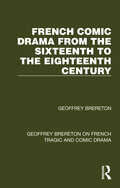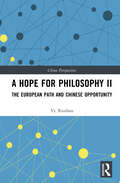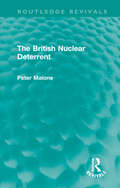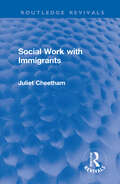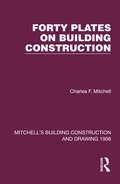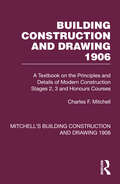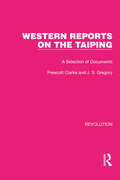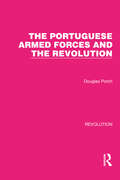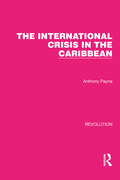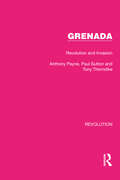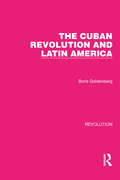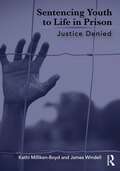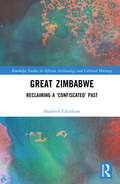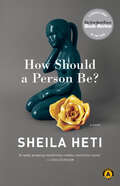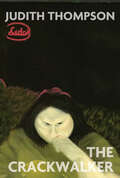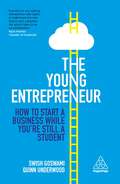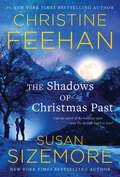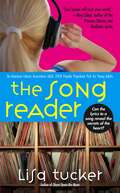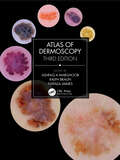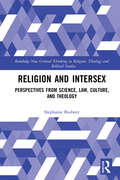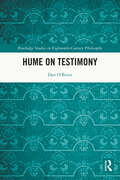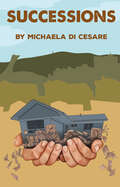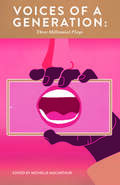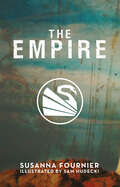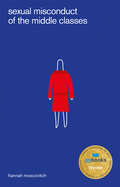Special Collections
Benetech’s Global Certified Accessible Titles
Description: Benetech’s GCA program is the first independent third-party EPUB certification to verify ebook accessibility. By creating content that is born accessible, publishers can meet the needs of all readers. Learn more: https://bornaccessible.benetech.org/
- Table View
- List View
French Comic Drama from the Sixteenth to the Eighteenth Century
by Geoffrey BreretonIn tracing the course of French comedy from the Renaissance, through the age of Louis XIV and the eighteenth century, to the eve of the Revolution, originally published in 1977, Geoffrey Brereton shows how it evolved from the crude farces and experimental plays of the sixteenth century to become a rich and highly sophisticated dramatic genre. The main emphasis is on the work of the principal dramatists, notably Molière (whose plays and career are given a detailed and enlightening treatment), Corneille, Scarron, Marivaux and Beaumarchais, with some space devoted to the more neglected writers, such as the ‘cynical generation’ of Dancourt, Regnard, Lesage and others; and all the plays are seen in the context of the theatrical conventions that helped to shape them. Different types of comedy are analysed, including comedy of character and of manners, as well as the romantic, burlesque and bourgeois forms and the development of the opéra-comique. At the same time Dr Brereton examines the influences on French comedy – influences as varied as those of the farce, the Italian commedia dell’arte, the Spanish comedia and the eighteenth century drame – and the way in which these were absorbed and exploited by French comic dramatists. Since comedy, more than any other kind of drama, reflects the contemporary social scene, attention is drawn to social conditions and attitudes, and some of the more striking parallels with modern social preoccupations are pointed out. Written in a very lively and readable style, and containing much stimulating and original comment, as well as providing the basic facts, it gives a considerable insight into the nature of French comedy during its most formative and fruitful period. A substantial bibliography and other reference material increase the usefulness of this book to the student of French drama.
A Hope for Philosophy II
by Ye XiushanAs the final work by Ye Xiushan, one of the most famous philosophers and philosophy scholars in China, this two-volume title scrutinizes the historical development of both Chinese and Western philosophies, aiming to explore the convergence between the two philosophical traditions.Combining the historical examination and argumentation based on philosophical problematics, the two-volume set expounds the key figures and schools and critical thoughts in both Western and Chinese philosophical histories. The second volume retraces the origin and development of Chinese philosophy and reveals its focal grounds, i.e. a trinity of man, Heaven, and earth, which helps explain why and how it diverges from Western way of philosophizing. This book also delineates the diachronic transitions of Chinese philosophy that critically embrace different schools of thought throughout history, including Confucianism, Daoism, Buddhism, and Marxism, etc., and then constitutes an organic whole. To elicit the potential for a new transformation of contemporary Chinese philosophy, the author encourages a constructive dialogue between the Chinese and Western philosophies.This title will appeal to scholars, students, and general readers interested in philosophical history, comparative philosophy, Chinese philosophy, and Western philosophy ranging over Greek philosophy, German classic philosophy, and contemporary continental philosophy.
The British Nuclear Deterrent
by Peter MaloneThe United Kingdom was the first country to undertake atomic energy research and development for military purposes. In April 1940 the British government commissioned a group of scientists to study the possibilities of manufacturing a ‘uranium bomb’ in wartime. Originally published in 1984, this book traces the development of British nuclear weapons from those early times to the present. It examines the decisions of Atlee and the MacMillan governments in sustaining the nuclear deterrent through the hydrogen bomb and the Polaris programme, and discusses in detail the decision to proceed with Trident. Throughout the narrative is set against the background of British domestic politics and Anglo-American relations. The book demonstrates why for nearly forty years British governments remained committed to an independent nuclear deterrent as the last line of defence should NATO fail.
Social Work with Immigrants
by Juliet CheethamPeople whose work brings them into contact with immigrants and their families are concerned about the serious personal and social problems they may face in establishing themselves in Britain. Originally published in 1972, Juliet Cheetham here explores the origin and nature of these difficulties and discusses the contributions and limitations of social work in meeting the needs of immigrants, their relatives and some of the organizations involved with them at the time. Drawing on her own field experience, the author deals with fundamental issues in race relations, together with the problems of poor urban areas in which most immigrants have settled. She also considers the backgrounds of some of the main immigrant groups, their family structure, and the pressures and anxieties they experience in moving into a new environment. She examines as well the special skills and understanding that social workers in this field need to develop. This is a perceptive study which raised fundamental questions about the values, objectives and methods of social work at the time. Even today it will also provide social workers with a stimulus to re-think the basis of some of their activities. This book is a re-issue originally published in 1972. The language used, and assumptions made, are a reflection of its era and no offence is meant by the Publishers to any reader by this re-publication.
Forty Plates on Building Construction
by Charles F. MitchellOriginally published in 1891, this volume was a companion volume to the Elementary and Advanced volumes of Building Construction and Drawing. The exquisite technical drawings give a technical level of detail which is invaluable for the study of late 19th Century construction methods and materials and cover brickwork and masonry, carpentry, joinery, plumbing, roof and iron work.
Building Construction and Drawing 1906
by Charles F. MitchellOriginally published in 1881, but here reissuing the 1906 edition with a new introduction by Stephen J. Scaysbrook, the Mitchell’s Building and Construction Stage 2, 3 and Honours book offers an unparalleled insight into historic construction techniques and materials. Originally written to provide a concise handbook and guide for students and for practitioners, this reissue of Mitchell’s 1906 Advanced and Honours edition now provides a valuable addition to building pathology, allowing students and practitioners to research construction methods and materials pertinent to the period.
Western Reports on the Taiping
by Prescott Clarke and J.S. GregoryThis book, first published in 1982, collects together a wide range of Western reportage on this major revolt in nineteenth century China. The extracts are contemporary, from eyewitnesses, and come from diplomatic and missionary reports, from books, newspapers, private journals, travel accounts and diaries. They provide a good overview of the response to this major crisis of Chinese society over a twenty-year period and the Western presence in mid-nineteenth century China.
The Portuguese Armed Forces and the Revolution
by Douglas PorchThis book, first published in 1977, traces the origins of the left-wing Portuguese army rebellion of 1974 that overthrew the 50-year-old authoritarian regime of Prime Ministers Salazar and Caetano to the traditional political independence of the armed forces, their increasingly strained relations with the regime, and finally to the colonial wars which brought professional discontent to boiling point. The Portuguese revolution which followed provides a unique laboratory for the study of an army in crisis, the strains which the attempt by officers to direct the political life of the country after April 1974 placed on military organisation; the traditional career patterns and attitudes of soldiers and on discipline. It examines the role of officers in government and the day-to-day problems which political upheaval created in every barracks. This is a study both of the armed forces in politics and politics in the armed forces, placed within the larger context of the revolution.
The International Crisis in the Caribbean
by Anthony PayneThis book, first published in 1984, presents a comprehensive survey of the forces of change that operate in the Caribbean, an area of political instability at the time. It examines the internal politics of the different countries and considers the roles of the United States, Cuba, the European and new Latin American powers in the political conflicts, coups and revolutions.
Grenada
by Anthony Payne and Paul Sutton and Tony ThorndikeThis book, first published in 1984, analyses the background to the revolution in Grenada and details the course of its progress, examining the reasons why it faltered and failed. International factors played no small part in these events, setting the agenda for the internal processes of the revolution and bringing it to an end. The book also examines closely the US-led invasion of this tiny island and its aftermath.
The Cuban Revolution and Latin America
by Boris GoldenbergThis book, first published in 1965, is a scrupulously fair study of the origins and evolution of Castroism and an assessment of the impact of the Cuban revolution and of Castro’s subsequent domestic and foreign policies on the rest of Latin America. In this analysis it takes into account the great differences – social, economic and cultural – between the countries of the area and looks at the foreign policies of Latin American countries as well as the United States and the role of international Communism.
Sentencing Youth to Life in Prison
by James Windell and Kathi Milliken-BoydThis book analyzes the impact of the U.S. Supreme Court rulings deeming juvenile life without parole (LWOP) sentences to be cruel and unusual punishment. These Court decisions brought about controversy and resistance in the criminal justice field, while at the same time providing hope for those 2,300 people who never thought they had a chance to experience life as an adult outside prison. By looking in depth at the lives of some of the individuals serving life terms, and understanding both the prosecutors who oppose review and resentencing of juvenile lifers and those who are sincerely following the Supreme Court’s guidelines, this book provides a comprehensive understanding of the issues – as well as the people – involved in the sentencing (and potential resentencing) of juveniles to life without the possibility of parole. The authors provide unique, perceptive and straightforward profiles on some of the prisoners who were ultimately sentenced to LWOP after being involved in criminal offenses committed before their 18th birthdays. The book poignantly features the experiences of young people who did not commit a murder yet were still sentenced to life terms, but also delves into the perspectives of the families of victims of juvenile offenders, prosecutors on both sides of the issue, psychologists who have interviewed many of the juvenile lifers and advocates for change in the way juveniles are treated by the criminal justice system. The decisions in Miller v. Alabama and Montgomery v. Louisiana clearly demonstrated that the Court’s view of juveniles evolved over decades to reflect advances in our understanding of the unique characteristics of youth and their involvement in juvenile crimes. This book takes the position that the sentence of life without the possibility of parole for youth is wasteful of both human lives and scarce public resources. The authors write about the human concerns on both sides of the question, and, ultimately, allow readers to make their own decisions about how society should best handle juvenile offenders. This engaging ethnographic treatment will appeal to students and scholars of criminology, corrections, juvenile justice, and delinquency; practitioners working in social policy; and all those interested in a criminal justice system capable of positive outcomes for involved youth.
Great Zimbabwe
by Shadreck ChirikureConditioned by local ways of knowing and doing, Great Zimbabwe develops a new interpretation of the famous World Heritage site of Great Zimbabwe. It combines archaeological knowledge, including recent material from the author’s excavations, with native concepts and philosophies. Working from a large data set has made it possible, for the first time, to develop an archaeology of Great Zimbabwe that is informed by finds and observations from the entire site and wider landscape. In so doing, the book strongly contributes towards decolonising African and world archaeology. Written in an accessible manner, the book is aimed at undergraduate students, graduate students, and practicing archaeologists both in Africa and across the globe. The book will also make contributions to the broader field such as African Studies, African History, and World Archaeology through its emphasis on developing synergies between local ways of knowing and the archaeology.
How Should a Person Be?
by Sheila HetiA brilliant portrayal of finding a beautiful life by one of Canada's most exciting literary talents, now available as an Anansi Book Club edition featuring discussion questions.How Should a Person Be? is an unabashedly honest and hilarious tour through the unknowable pieces of one woman’s heart and mind, an irresistible torn-from-life book about friendship, art, sex, and love. Part literary novel, part self-help manual, and part racy confessional, it is a fearless exploration into the way we live now by one of the most highly inventive and thoughtful young writers working today.
The Crackwalker
by Judith ThompsonTeresa is sexy, seductive, and mentally challenged. Worshipped by her boyfriend, she turns tricks at $5, is addicted to Tim Hortons' doughnuts, lies without thinking, and overflows with endless kindness, but she continues to hold on to her limitless innocence. The Crackwalker captures the music, the dialect, and the unpretty realities of the inner city. First produced thirty years ago, Thompson's striking portrayal of the discarded class in Canada continues to move audiences today.
The Young Entrepreneur
by Swish Goswami and Quinn UnderwoodIf you have a great start-up idea and know how to think like an entrepreneur, but are still at college or university, then this book will show you how to run your business without having to drop out. Research shows that Generation Z are the most entrepreneurial generation yet. If you don't want to wait until you graduate before launching the next big thing, then this book - written by successful young entrepreneurs Swish Goswami and Quinn Underwood - is for you. Packed with practical and realistic advice The Young Entrepreneur really cuts through the noise surrounding business innovation and makes a clear case for starting your own company while you're young. Featuring inspiring examples and invaluable resources to give you the tools you need, this book is your one-stop guide to jump-start your entrepreneurial journey.
The Shadows of Christmas Past
by Christine Feehan and Susan SizemoreDark magic heats up the holiday season as two sizzling New York Times bestselling authors team up for a seductive Christmas collection!Magic is in the air this Christmas—but is it good or evil? In this sexy yuletide anthology from two of the hottest names in paranormal romance, animal instincts take over... In Christine Feehan&’s &“Rocky Mountain Miracle,&” the sparks flying on a remote ranch could melt all the snow in Wyoming when an injured horse brings together a rugged womanizer with a dangerous reputation and an irresistible veterinarian rumored to cast spells. But does her magic touch work on animals and men? A small-town woman is shocked when the injured wolf she takes back to her kennel turns into a man in Susan Sizemore&’s &“A Touch of Harry.&” The only thing more difficult to hide than his stunning escape is the burning desire she feels for this stranger who brings out her wild side.
the song reader
by Lisa TuckerShe can hear the music in peoples' souls. Mary Beth and her younger sister Leeann are trying to support themselves in their small Southern hometown. So Mary Beth works to make ends meet by practicing her own unique talent: "song reading. " By making sense of the song lyrics people have stuck in their heads, Mary Beth can help people make sense of their lives. In no time, Mary Beth's readings have the entire town singing her praises, including the handsome scientist Ben, who falls hard for Mary Beth and her unearthly intuition. What happens when she can't make out the lyrics? When Mary Beth reveals a long-muted secret in the community, however, she turns off the music and gives up song reading for good. Soon everyone's lives are out of tune: Leeann worries she'll never graduate from high school, and Ben can't conduct his experiments. Without Mary Beth's music the town's silence is louder than ever. Could it be that all the lyrics to all those foolish love songs really aren't so foolish after all?
Atlas of Dermoscopy
by Ashfaq A Marghoob Ralph Braun Natalia JaimesThe much awaited third edition of the leading reference book in dermoscopy has undergone comprehensive revisions to all chapters, with updates and expanded content providing the reader with a more comprehensive and in-depth coverage of skin conditions, ranging from skin neoplasia to hair, nails, infections and inflammatory diseases. This compilation of contemporary dermoscopy knowledge will benefit the novice in building expertise and benefit experienced practitioners also by providing nuanced insights. Prepare to embark on a journey of learning as leading international experts in the field of dermoscopy explain via text and annotated exemplar images the amazing world of subsurface cutaneous colors and structures visible through a dermatoscope!
Religion and Intersex
by Stephanie A. BudweyThis book considers the situation of intersex people who have faced erasure in the areas of science, law, culture, and theology due to the assumption that all humans are either ‘female’ or ‘male.’ Centered in interviews conducted with German intersex Christians, this book argues that moving from a paradigm of sexual dimorphism to sexual polymorphism will help promote the full humanity and flourishing of intersex people by creating a world where intersex individuals are no longer coerced and/or forced to undergo non-consensual, medically unnecessary treatment, no longer experience human rights violations because of their lack of legal protection, no longer feel inhuman and Other due to epistemic injustice that stems from socio-cultural norms and stereotypes, are no longer told they are not made in God’s image as a result of a sexually dimorphic understanding of Genesis 1:27, and no longer feel excluded and invisible in worship services that do not recognize them. This combination of the practical and the spiritual allows for a reconsideration of the medical treatment and pastoral care that should be available to intersex people. This book will be helpful to those in the disciplines of science, law, culture, and theology, particularly those in gender and theological studies and those already in and studying for lay and ordained ministry.
Hume on Testimony
by Dan O'BrienThis book is the first devoted to Hume’s conception of testimony. Hume is usually taken to be a reductionist with respect to testimony, with trust in others dependent on the evidence possessed by individuals concerning the reliability of texts or speakers. This account is taken from Hume’s essay on miracles in An Enquiry concerning Human Understanding. O’Brien, though, looks wider than the miracles essay, turning to what Hume says about testimony in the Treatise, the moral Enquiry, the History of England and his Essays. There are social aspects of testimonial exchanges that cannot be explained purely in terms of the assessment of the reliability of testifiers. Hume’s conception of testimony is integrated with his account of how history informs our knowledge of human nature, the relation between sympathy and belief and between pride and the conception we have of our selves, the role played by social factors in the judgment of intellectual virtue, and the importance Hume places on epistemic responsibility and the moral and personal dimensions of testimonial trust. It is not possible to focus on testimony without allowing other aspects of our nature into the frame and therefore turning also to consider sympathy, wisdom, history, morality, virtue, aesthetic judgment, the self and character. O’Brien argues that Hume’s reliance on the social goes deep and that he should therefore be seen as an anti-reductionist with respect to testimony. Hume on Testimony will be of interest to researchers and advanced students working on Hume and on early modern and contemporary approaches to the epistemology of testimony.
Successions
by Michaela Di CesareAfter the unexpected death of their parents, two second-generation Italian Canadian brothers must come together to decide whether to hold on to the family home, which is full of secrets and hoarded junk, or save what’s left of their strained relationship. When Anthony, an uptight lawyer running for office, arrives with his former actor-turned-campaign-manager wife Cristina, they’re set on signing away the house and everything that comes with it. But Enzo, a disorganized plumber, and his pregnant girlfriend Nat have other plans. The pleasantries quickly turn to tense deliberations that unearth dramatically differing views of the group’s past experiences and present values. This clever family dramedy takes a close look at issues that affect modern second-generation immigrant families in Canada—class differences, antiquated old-world beliefs, and a crumbling Canadian dream.
Voices of a Generation
by edited by Michelle MacArthurVoices of a Generation gathers three Canadian plays that crack open millennial stereotypes to reveal a generation’s complex and varied experiences. zahgidiwin/love by Frances Koncan follows Namid through multiple generations: as a survivor of abuse in a residential school in the 1960s, as a missing woman held in a suburban basement in the 1990s, and as the rebellious daughter of a tyrannical queen in a post-apocalyptic, matriarchal society. A comedy about loss in the era of truth and reconciliation, zahgidiwin/love uses a mash-up of theatrical styles to embody the millennial creative impulse to remix and remake while presenting a vital perspective on what decolonization might look like both on and off stage. The Millennial Malcontent by Erin Shields is a gender-swapped adaptation of Sir John Vanbrugh’s Restoration Comedy The Provoked Wife, following a group of millennials during a night out as they search for love and sex and document it all on social media. Satirizing every trope from social media stardom to economic precarity to slacktivism, Shields reveals the loneliness lurking under every smiling profile photo. In Smoke by Elena Belyea, Aiden’s ex Jordan arrives at Aiden’s door to confront her about the allegation that Jordan sexually assaulted her two years ago, forcing them to discuss their conflicting memories of their last night together and whether and how they’re going to move forward. With Jordan meant to be performed by either a cis-male or cis-female actor, Smoke is a nuanced examination of issues and perceptions surrounding sexual assault and consent.
The Empire
by Susanna FournierExplore a world on the edge of change through three epic stories spanning five hundred years of imagined history, unpacking systems of power and what we are capable of in the pursuit of freedom. The story starts in The Philosopher’s Wife. Deep in the North, a philosopher exiled for promoting his atheist work amidst a bloody religious war yearns to ignite a revolution, but his personal life has collapsed into chaos. What begins as a desperate attempt to cure his wife’s animalistic behaviour erupts into a power struggle between the sexes, unleashing violent reckonings while the world outside hurtles towards an epoch-changing revolution. Over twenty years later, The Scavenger’s Daughter examines the true face of empire as Northern forces continue to march against the South, “liberating” all who stand in their way. In a landscape blown apart by war, we follow Jack and Ash, orphan soldiers belonging to the Black Swan army, trying to survive the camp, toxic masculinity, and each other until they can be free. When Jack returns to camp, his freedom having been bought for him by a mysterious philosopher, he believes his new life is just around the corner. But as rations wear thin and the king seizes the opium trails, the camp is thrown into chaos, putting everything Jack and Ash have known—including Jack’s first love, Sarah—at risk. Centuries later, in Four Sisters, we meet Sarah again as a woman and former Madam who has survived death, the toppling of regimes, and centuries of war. When a mysterious plague breaks out, she is forced to relocate to a quarantined zone called “The Skirts” with four young girls who were orphaned by the women she once employed. But when a strange doctor arrives and discovers the girls are plague-positive, Sarah must decide whether to go ahead with an experimental treatment or none at all. As time itself begins to erode, this found family of women must face loss, love, and their individual struggles for power in a violent world. For fans of Game of Thrones, The Handmaid’s Tale, and The Mists of Avalon, The Empire is both foreign and shockingly familiar, leaving you asking, how did we get here, and where are we going?
Sexual Misconduct of the Middle Classes
by Hannah MoscovitchThe archetypal student-teacher romance is cleverly turned on its head for the post-#MeToo era in this striking new play by the acclaimed author of What a Young Wife Ought to Know and Bunny. Jon, a star professor and author, is racked with self-loathing after his third marriage crumbles around him when he finds himself admiring a student—a girl in a red coat. The girl, nineteen-year-old Annie, is a big fan of his work, and also happens to live down the street. From their doorways to his office to hotel rooms, their mutual admiration and sexual tension escalates under Jon’s control to a surprising conclusion that will leave you wanting to go back and question your perceptions of power as soon as you finish.
